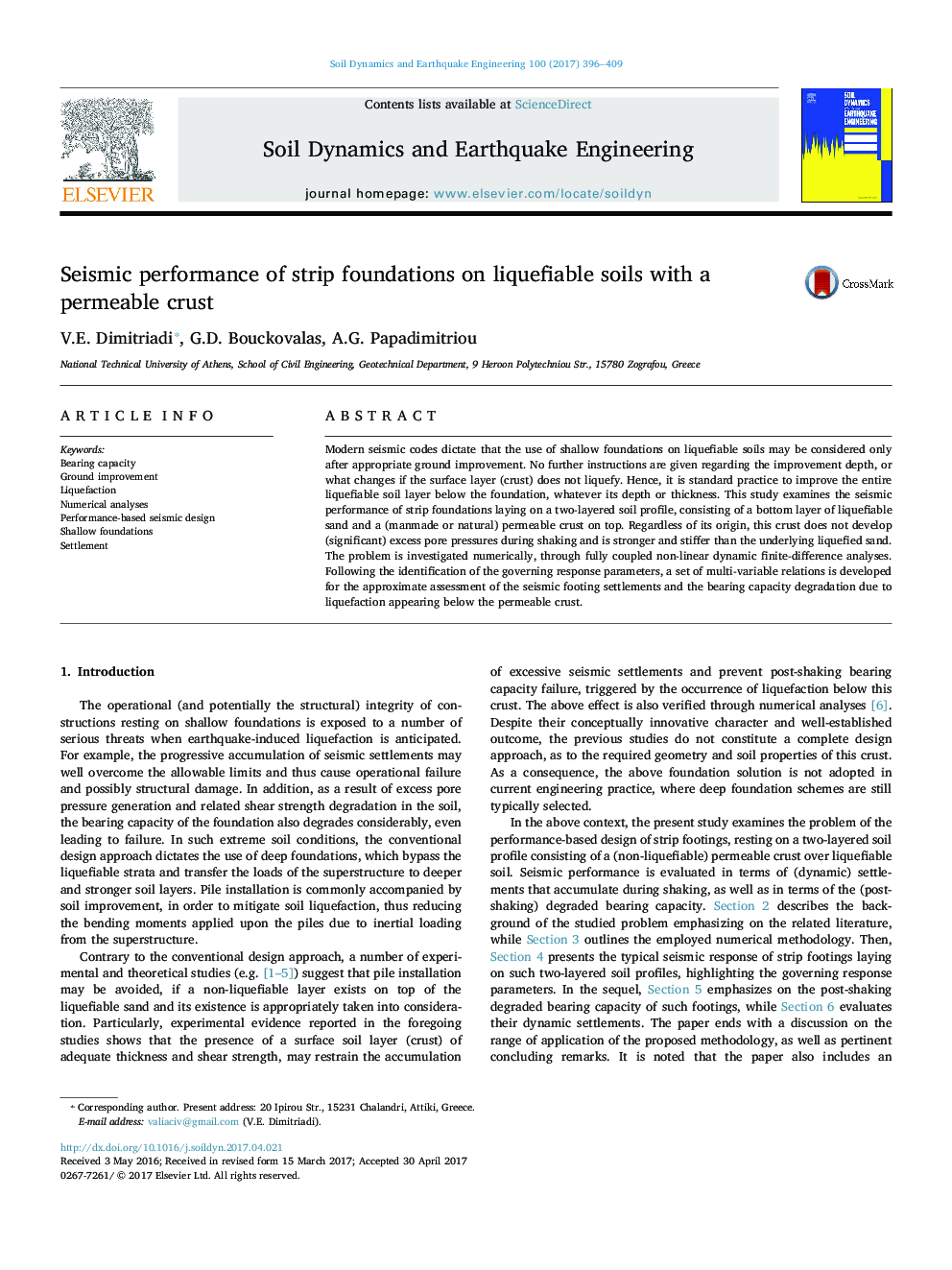| کد مقاله | کد نشریه | سال انتشار | مقاله انگلیسی | نسخه تمام متن |
|---|---|---|---|---|
| 4927035 | 1431693 | 2017 | 14 صفحه PDF | دانلود رایگان |
عنوان انگلیسی مقاله ISI
Seismic performance of strip foundations on liquefiable soils with a permeable crust
ترجمه فارسی عنوان
عملکرد لرزه ای پایه های نوار در خاک های مایع با پوسته نفوذ پذیر
دانلود مقاله + سفارش ترجمه
دانلود مقاله ISI انگلیسی
رایگان برای ایرانیان
کلمات کلیدی
ظرفیت تحمل، بهبود زمین، تبدیل به مایع، تجزیه و تحلیل عددی، طراحی لرزه ای مبتنی بر عملکرد، پایه های کوچک، توافق،
ترجمه چکیده
کدهای لرزه ای مدرن می گویند که استفاده از پایه های کم عمق در خاک های قابل مایع ممکن است تنها پس از بهبود مناسب زمین مورد توجه قرار گیرد. در مورد عمق بهبودی هیچ دستورالعمل بیشتری ارائه نمی شود یا اینکه اگر لایه سطح (پوسته) نشت ندهد تغییر می کند. از این رو، عمل استاندارد برای بهبود کل لایه خاک مایع زیر پایه، هر چه عمق یا ضخامت آن است. این مطالعه به بررسی عملکرد لرزه ای پایه های نوار بر روی یک پروفیل خاک دو لایه می پردازد که شامل یک لایه ی پایین از شن و ماسه مایع و پوسته نفوذ پذیر (منسوخ شده یا طبیعی) است. صرف نظر از منشاء آن، این پوسته فشارهای منفی اضافه (قابل توجهی) را در طی لرزش ایجاد نمی کند و قوی تر و سخت تر از شن و ماسه مایع زیرزمینی است. این مسئله به صورت عددی، از طریق تجزیه و تحلیل اختلاط محدود و اختلاف پویا غیر خطی کاملا مرتبط شده است. پس از شناسایی پارامترهای واکنش حاکم، مجموعه ای از روابط متغیر متغیر برای ارزیابی تقریبی ارقام پایه لرزه ای و تخریب ظرفیت تحمل به دلیل مایع شدن زیر پوسته نفوذ پذیر ایجاد می شود.
موضوعات مرتبط
مهندسی و علوم پایه
علوم زمین و سیارات
مهندسی ژئوتکنیک و زمین شناسی مهندسی
چکیده انگلیسی
Modern seismic codes dictate that the use of shallow foundations on liquefiable soils may be considered only after appropriate ground improvement. No further instructions are given regarding the improvement depth, or what changes if the surface layer (crust) does not liquefy. Hence, it is standard practice to improve the entire liquefiable soil layer below the foundation, whatever its depth or thickness. This study examines the seismic performance of strip foundations laying on a two-layered soil profile, consisting of a bottom layer of liquefiable sand and a (manmade or natural) permeable crust on top. Regardless of its origin, this crust does not develop (significant) excess pore pressures during shaking and is stronger and stiffer than the underlying liquefied sand. The problem is investigated numerically, through fully coupled non-linear dynamic finite-difference analyses. Following the identification of the governing response parameters, a set of multi-variable relations is developed for the approximate assessment of the seismic footing settlements and the bearing capacity degradation due to liquefaction appearing below the permeable crust.
ناشر
Database: Elsevier - ScienceDirect (ساینس دایرکت)
Journal: Soil Dynamics and Earthquake Engineering - Volume 100, September 2017, Pages 396-409
Journal: Soil Dynamics and Earthquake Engineering - Volume 100, September 2017, Pages 396-409
نویسندگان
V.E. Dimitriadi, G.D. Bouckovalas, A.G. Papadimitriou,
